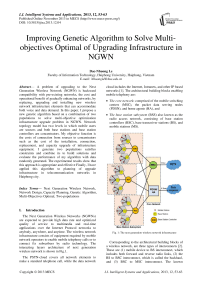Improving Genetic Algorithm to Solve Multi-objectives Optimal of Upgrading Infrastructure in NGWN
Автор: Dac-Nhuong Le
Журнал: International Journal of Intelligent Systems and Applications(IJISA) @ijisa
Статья в выпуске: 12 vol.5, 2013 года.
Бесплатный доступ
A problem of upgrading to the Next Generation Wireless Network (NGWN) is backward compatibility with pre-existing networks, the cost and operational benefit of gradually enhancing networks, by replacing, upgrading and installing new wireless network infrastructure elements that can accommodate both voice and data demand. In this paper, I propose a new genetic algorithm based on a combination of two populations to solve multi-objective optimization infrastructure upgrade problem in NGWN. Network topology model has two levels in which mobile users are sources and both base stations and base station controllers are concentrators. My objective function is the costs of connection from sources to concentrators such as the cost of the installation, connection, replacement, and capacity upgrade of infrastructure equipment. I generate two populations satisfies constraints and combine its to build solutions and evaluate the performance of my algorithm with data randomly generated. The experimental results show that this approach is appropriate and effective Finally, I have applied this algorithm to planning of upgrade infrastructure in telecommunication networks in Haiphong city.
Next Generation Wireless Network, Network Design, Capacity Planning, Genetic Algorithm, Multi-Objectives Optimal, Two-populations
Короткий адрес: https://sciup.org/15010499
IDR: 15010499
Текст научной статьи Improving Genetic Algorithm to Solve Multi-objectives Optimal of Upgrading Infrastructure in NGWN
Published Online November 2013 in MECS
The Next Generation Wireless Networks (NGWNs) are expected to provide high data rate and optimized quality of service to multimedia and real-time applications over the Internet Protocol networks to anybody, anywhere, and anytime. The wireless network infrastructure consists of equipment required by mobile network operators to enable mobile telephony calls or to connect fix subscribers by radio technology. The interacting layers architecture of next generation wireless network is shown in Fig.1.
The PSTN-cloud covers all network elements to make a standard telephone call, while the data network cloud includes the Internet, Intranets, and other IP based networks [1]. The architectural building blocks enabling mobile telephony are:
-
• The core network : comprised of the mobile switching centers (MSC), the packet data serving nodes (PDSN), and home agents (HA), and
-
• The base station subsystem (BSS) also known as the radio access network, consisting of base station controllers (BSC), base transceiver stations (BS), and mobile stations (MS).
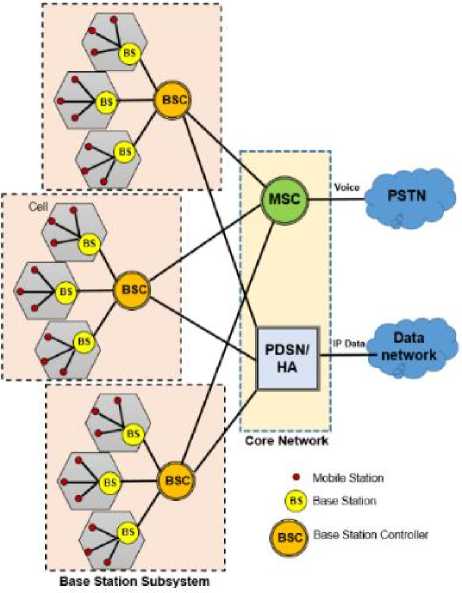
Fig. 1: The next generation wireless network infrastructure
Corresponding to the architectural building blocks of a wireless network, are three types of interconnects [2]. These are (1) mobile device to BS interconnect, which includes both forward and reverse radio links, (2) the BS to BSC interconnect, which is called the backhaul, and (3) BSC to MSC interconnect. The known hierarchical capacitated concentrator location problem, which is an extension of the concentrator location problem to multiple levels and a classical research issue in the telecommunications literature [3-6]. In [7], the authors studied the base station location and service assignment problem in a W-CDMA. A greedy strategy to optimal positioning of BSs for cellular radio networks and capacity planning of UMTS networks studied in [8-9]. A Tabu search and Genetic algorithm approach to cellular capacity expansion to maximizing the coverage area and minimizing the number of transmitters is presented in [10-11]. Yu et al in [12] proposed a set covering algorithm for given traffic and finding optimal solution configuration in a CDMA network. An alternate approach to capacity planning and expansion is introduced for 3G network system capacity without an increase in BSs using a cell splitting approach [13].
In latest papers [14-18], I have proposed a novel Particle Swarm Optimization and Ant Colony Optimization and Genetic algorithms to optimal location of controllers in wireless networks and centralized wireless access network. In this paper, I focus on the Multi-Objectives Optimization of Upgrading Infrastructure (MOOUI) in NGWN and propose a new Genetic algorithm to solve it. The rest of this paper is organized as follows: Section 2 presents the MOOUI problem formulation. Section 3 presents my new algorithm to solve it based on GA algorithm. Section 4 is my simulation and analysis results, and finally, section 5 concludes the paper.
-
II. Problem Formulation
In this section, I assume that network topology has m mobile users, n base stations, and p base station controllers. I introduce the following notation:
Table 1: Notation definition
|
Notation |
Meaning |
|
M |
Index set of Mobile user locations: M = { MS i , V i = 1.. m } |
|
N |
Index set of all Base Station (BS): N = N 1 О N 2 = { BS;, V j = 1.. n } N 1: Index set of existing BS; N 2: Index set of potential BS |
|
P |
Index set of Base Station Controllers (BSC): P = P1 О P 2 = { BSCk , V k = 1.. p } P 1: Index set of existing BSC; P 2: Index set of potential BSC |
|
T j |
Set of types available for BS , V j' e N |
|
S |
[ 1 if commonditytypeisvoice Set of commodity types: s = 1 | 2 if commonditytypeisdata |
|
Nt |
Index set of all BS of type t. N , = N 1 , 0 N 2 , |
|
Ds i |
Demand of commodity type s for mobile user MS , , V i e M |
|
MaxBS _ Cap |
Maximum capacity of BS, of type t , V j e N , . |
|
MaxBSC _ Cap |
Maximum capacity of BSCk , V k e P |
|
dij t |
Distance of mobile user MS, from BS ^ of type t V i e M , V j e Nt |
|
MaxBS _ Cov jt |
Maximum coverage range for BS of type t |
|
cost_connect |
Cost of connecting BS of type t to BSCk |
|
cost_install |
Cost of installing BSC k , V k e P 2 |
|
cost_upgrade |
Per channel cost of upgrading BS^ , V j' e N 1 |
|
cost_setup |
Cost of constructing and connecting BS,, V j' e N 2 |
The MOOUI problem in NGWN has two steps the initial assignment of MSs to BS and the connection of BS to BSC and capacity expansion and traffic increase with constraint specifies that:
-
• Each mobile user MS i will be assigned to exactly one base station BS j of type t
-
• Mobile users are within that base stations’ maximum range MaxBS _ Cov
-
• At most one base station of type t can exist at location j
-
• if a base station BS j is operated, it has to be connected to a BSC k and the BSC has to be active.
The capacity constraints of the model, in which we argue that BSs must have the necessary capacity to accommodate traffic demand of all demand types s for all MSs assigned to it and the BSC must have the necessary capacity to accommodate all BSs assigned to it.
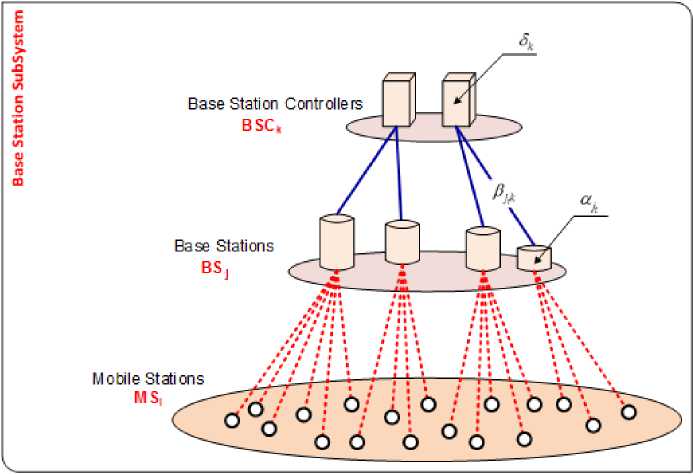
Fig. 2: The Initial Assignment step with indicator variables
In the first step, I use the indicator variables are:
8 k =1 1
if BSC isoperatedininitialassigment 0 otherwise
«3,
1 if BS of type t is operated 0 otherwise
в 3k =
Fig.2 shows an example of an existing initial assignment that each mobile user can be assigned to only one BS, while each BS has to be connected to a single BSC.
1 if BS oftype t isconnectedto BSC 0 otherwise
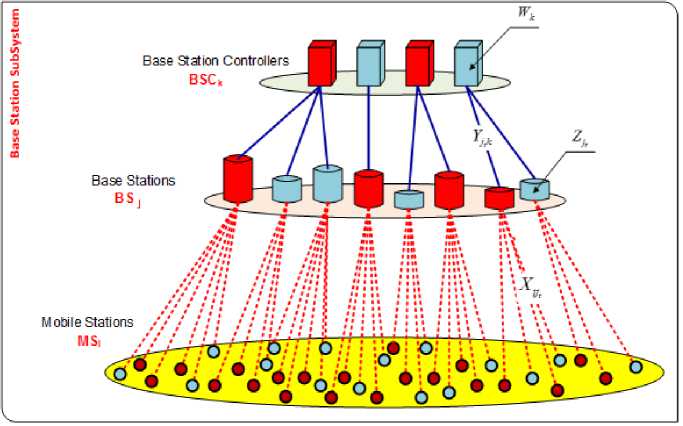
Fig. 3: The assignment after capacity expansion and traffic increase with decision variables
In the second step, I use the decision variables are:
[ 1 if mobile user MS, is connected to BS, X,, = ^ i j
J' I 0 otherwise
J 1 if BSj of type ‘ is connected to BSCk k I 0 otherwise
J 1 if BSj of type t isoperated j I 0 otherwise
J 1 if BSCk isoperated k I 0 otherwise
Fig.3 illustrates an assignment after capacity expansion and traffic increase, and indicates the respective decision variables. New wireless BSS infrastructure equipment with BS and BSC in red shades.
The objective of MOOUI is to minimize the total cost of expanding an initial wireless BSS to accommodate increased traffic demand. The MOOUI problem can be defined as follows:
np
Min ( ZZZ cost_connect№ ( Y,, - p j, )
J = 1 k = 1 t e T
+ Z cost_install k ( Wk - 3 k )
k e P2
+ Z cost upgrade , I Z MaxBS _ capjt ( Zjt - a j e N । ( t e Tj
+ zzcost_setup Z ) j e N2 ‘ e Tj‘ '
Subject to:
n
ZZXj. = 1, Vi = 1..m(9)
J=1 ‘ eTj djjXji < MaxCovZ, V i = 1.. m, J = 1.. n, t e T (10) ij ijt jt jtj
|
Z Zj, < 1, V J = 1.. n ‘ e T j |
(11) |
|
Z <1 z Y Jk , V J = i.7n , t e T j k = 1 |
(12) |
|
YJ k < W k , V k = 1.. p , J = 1.. n , t e T j |
(13) |
ZZZDjXj i=1 s=1 ‘ ‘‘ ZZ Z Yj.k < MaxBSC _ Cap, x Wfc, Vk = 1..P(15) J=1 t eTj‘ Xy. e{0,1}, Yjtk e{0,1}, Zj e{0,1}, Wk e{0,1} V i = 1.. m ,j' = 1.. n, k = 1.. p, t e T III. A New Genetic Algorithm for the MOOUI A. Represent and decode an individual In this section, I present a new genetic algorithm for the MOOUI problem with two populations POP and POP . • The encoding of the POPX configuration is by means of matrix X = (xj )nxm , (i = 1..n,J' = 1..m) where xi =1 means that mobile user MSi has been connected to base station BS , and otherwise, xi =0. • The encoding of the POPY configuration is by means of matrix Y = (y jk )mp, (j' = 1..m, k = 1..p) , where y k=1 means that base station BS has been connected to base station controller BSCk, and otherwise, y k=0. B. Initialization I use fully random initialization in order to initialize the individuals POP ensure that the individual x satisfies constraints in (9)(10)(14) and (16). Each individual x, I fully random initialization in order to initialize the individuals POP ensure that the individual y satisfies constraints in (12)(13)(15) and (16). C. Crossover Operator This operator minics the mating process in the nature. To do crossover in POP , two individuals are picked first and two integer numbers (i, )(crossover point is xi ) are generated randomly between [1,n] and [1,m] (where n is number of MSs and m is number of BSs). Then the offspring is generated by interchanging the second halves of its parent, as illustrated in Fig.4. In the crossover stage, the algorithm examines all pairs of individuals. It begins with the pairs that include the individual with a higher fitness value until the population size becomes twice of the original size. Similar, I apply crossover operator to POP . Parents \ x x x x x20 x21 x10 xi0 V Childrent I xn 0 xn0 nm ) г nm n N0 Fig. 4: An example of crossover operator for population POPX nm D. Mutation Operator The mutation operation is one kind of random change in the individual of POPX . In my algorithm, pointwise mutation is adopted, in which one gene in the individual is changed with a certain probability, referred to as the mutation probability. This operator allows the algorithm to search for new and more feasible individuals in new corners of the solution spaces. To do mutation, an individual is randomly selected from the BS and the selected BS is called the mutation point, as illustrated in Fig.5. Parents Ch ldrent x10 x11 x1j ■• x1 m ' r x10 x11 x1j x1 m x 20 x21 x2j x2m x 20 x21 x2j x 2 m ^ x0 x1 ... xj = r •■ x m x0 x1 ... xj = r . '- I xn 0 xn0 xn0 xnm , < xn 0 xn0 xn0 xnm 1 Fig. 5: An example of mutation operator for population POP The mutation stage is implemented until either population size becomes twice of the original size or all individuals in the current generation are examined. Similar, I apply mutation operator to POP . F. My GA algorithm proposed The pseudo-code of my algorithm as follows: A NEW GENETIC ALGORITHM FOR THE MOOUI BEGIN INITIALISE population POPX with random candidate solutions; REPEAT 1. SELECT parents in POPX ; 2. RECOMBINE pairs of parents in POP ; 3. CROSSOVER the resulting offspring in POPX ; 4. MUTATION the resulting offspring in POPX ; 5. FOR each each candidate x e POPX DO 5.1 INITIALISE 5.2. SELECT parents in POPY ; 5.3. RECOMBINE pairs of parents in POPY ; 5.4. CROSSOVER the resulting offspring in POPY ; 5.5. MUTATION the resulting offspring in POPY ; 5.6. COMBINE Solution 6. EVALUATE FUNCTION new solutions s by formula (8); 7. SELECT individuals x for the next generation; Population POPY with random candidate Solutions y e POP follows candidate x e POPX ; s = {(x, y) | x e POP, y e POP } UNTIL (TERMINATION CONDICTION is satisfied) END IV. Experiments and Results A. Simulation Conditions In the simulation, I have tackled several MOOUI instances of different difficulty levels. There are 10 MOOUI instances with values for M, N and P shown in Table II. I have already defined parameters GA algorithm to tackle these problems can be specified as below in Table III. E. Evaluation function After the mutation, each solution s = {(x,y) | x e POPx ,y e POPy } is satisfies constraints in (9)-(16). The cost function of solution s computed by formula (8). Table 2: Main characteristic of the problems tackled Base Stations Base Stations Controllers Problem # Mobile Users (M) N N1 N2 Types P P1 P2 Types (1) 10 4 3 1 1 3 2 1 1 (2) 20 5 3 2 2 4 3 1 2 (3) 30 6 3 3 3 4 2 2 3 (4) 40 7 3 4 3 5 2 3 3 (5) 50 10 6 4 3 5 2 3 3 (6) 60 15 10 5 4 10 5 5 4 (7) 70 15 8 7 4 10 6 4 4 (8) 80 20 10 10 5 15 10 5 5 (9) 90 25 15 10 7 15 8 7 6 (10) 150 40 20 20 10 20 10 10 7 Table 3: The GA Algorithm Specifications Representation Matrix X = (Xj ) nxm , Y = (yjk )„xp Recombination One point crossover Recombination probability 70% Mutation Each value inverted with independent probability pm per position Mutation probability Pm = V m Parent selection Best out of random two Survival selection Generational Population size POPX= POP = 500 Number of offspring 500 Initialization Random Termination condition No improvement in last 100 generations B. Numerical Analysis I evaluate the performance of my algorithms to optimize of capacity expansion with multi-objectives. The experiment was conducted on Genuine Intel® CPU Duo Core 3.0 GHz, 2 GB of RAM machine. I ran experiment GA algorithm implemented using C language. Fig. 6: Comparing value of capacity expansion in the MOOUI instances tackle Comparing values of objective function between initial solution and optimal solution shown in Fig.6 with Population size POPX=POPY=500 and termination condition is 100 generations. Fig.7 shown time processing of MOOUI instances tackle. Fig. 7: Time processing MOOUI instances tackle The results show that problems with the small number of M, N, P such as problem #1, #2, #3, #4 and #5, algorithm has approximate optimal results fast with small interactions. However, when the problem size is large, the optimal results may be slower such as problem #6, #7, #8, #9 and #10. Convergence speed is not the same and depend on the distribution of parameters data. Fig.8 show an existing initial assignment of problem #3. MS20 MS14 MS4 MS10 BS3 ;MS19 MS3 BS4 BSC2 MS27 MS18 MS25 MS13 MS12. MS8 BS2 ' MS11 в MS1 =(6.12,10.66) 3 MS2 = (6.84, 5.62) 3 MS3 = (13.76, 9.46) 3 MS4 = (11.19, 9.98) 3 MS5 = (8.92,9.38) 3 MS6 = (6.86,6.55) Э М57 = (8, 6) 3 MS8 = (8.34,3.7) 3 MS9 = (9.52,7.26) 3 MS10 = (5.66, 9.66} Э MS11 =(12.24,9.62) 3 MS12 = (8.98, 345} 3 MS13 = (7.18,4.3) 3 MS14 = (10.22,10.48) Э MS15 = (6.5,8.29) 3 MS16 = (11.34,11.53) . 3 MS17 = (5.53, 8.12) 3 MS18 = (12.06,6.53) J MS19 = (843, 8.72) 3 MS20 = (7.32,11.26) 3 WS21 = (9.8,4.02) 3 MS22 = (13.42,10.7) 3 MS23 = (9.28, 6.24) 3 MS24 = (10.14, 6.12) 3 MS25 = (7.14, 4.84} 3 MS26 = (9.83,8.27) 3 MS27 = (10.57,742} 3 MS28 = (11.14,6.4) 3 MS29 = (10.99,5.02) 3 MS30 = (7.02,7.46} 3 BS1 =(6.38,7.63) 3 BS2 = (11.83,10.62) 3 BS3 = (6.78,9.32) J BS4 = (11.14, 8.28) J BS5 = (10.12, 6.7} 3 BS6 = (8.64,4.92) 8 BSC1 =(5.64,5.74) 3 BSC2 = (12.85,74} J BSC3 = (10.06, 11.16} J BSC4 = (8.3, 7.27) •. MS22 BSC3 eMS16 MS17Z • №15' MS30 вйс) / иву .(Й82" " Л ......... ESC4 ms6 MS5 MS28 X „ I , ; MS29 iBs6xMS21 - / -X>*. MS-24 MS26 MS9 MS1 Fig. 8: An existing initial assignment of problem #3 In which, there are three types of base station are: • Type 1: (BS1,BS6) • Type 2: (BS2,BS3) • Type 3: (BS4,BS5) • BS2, BS3 BSC2, BSC4 are existing BSCs; • BSC1, BSC3 are potential BSCs; • BS3, BS4, BS6 are existing BSs; • BS1, BS2, BS5 are potential BSs. • MS6, MS16, MS22, MS29 are not connected. Fig.9 show an optimal solution with BSC2 is replaced by BSC3, BS4 is replaced by BS2 and BS5. BS1 is added and connect to BSC4. Red edges are replace connections and black edges are existing connections. Fig. 9: An optimal capacity expansion of problem #3 To evaluation the effect of population size and number of iterations to the value of the objective function. I consider the problem #3 with the iterations can vary from 100 to 500 and fixed population size is 500, comparing results are shown in Fig.10 and Fig.11. Fig. 10: Comparing objective function values of pro.#3 with different number of interactions Fig. 11: Comparing time processing of problem #3 with different number of interactions To comparing the problem #3 with the population size can vary from 500 to 1000 and fixed iterations size is 100, comparing results are shown in Fig.12 and Fig.13. 110.00 115.00 120.00 125.00 130.00 135.00 140.00 145.00 Objective function values Fig. 12: Comparing objective function values of problem #3 with different population size Fig. 13: Comparing time processing of problem #3 with different population size The experimental results show that the algorithm can be implemented with the big number of interactions and large population size in polynomial time. From this result, I confirmed that this is a promising approach to solve this problem. C. Applied to planning of upgrade infrastructure in telecommunication networks in Haiphong city Haiphong is a city located on the edge of the Red River in Vietnam. Also known as the ‘city of flame flowers’, it is a beautiful city and a major industrial and commercial hub. Home to a populace of about 1,600,000 people, Haiphong is the third most populated city in Vietnam. According to Strategies to development Post and Telecommunications in City Haiphong from 2009 to 2020 of Department of Information Communication [21-22], switching network in Haiphong most use the system switchboards switched channels as task switching local voice traffic. In addition, NGWN is in the process to deploy converged voice networks, data and fixed networks, mobile networks into a common, provide new services based on NGN for subscribe on the city. Present in the Haiphong city area has 06 mobile suppliers networking: (1) Vinaphone network of telecommunications services company GPC construction and management. Existing network has a mobile switchboard and 110 mobile stations broadcasting, mainly installed using common infrastructure and management with stations of Telecommunications Institute Haiphong. (2) MobiFone network of Mobile Information Center 5th build and manage, the network currently has 94 stations broadcasting mobile. Mainly been installed at stations telecommunications, postal districts, individual organizations on City area. (3) Viettel Mobile Network of Viettel Telecom build, manage and organize the business in the city. Existing network has 260 stations broadcast mobile revenue, mainly installed at the organizations and individuals in the city. (4) EMobile Network of Telecommunications and Information Power Company build and manage. Existing network has 79 stations broadcasting on mobile city. (5) SFone Network by ST telecom (units of SPT) to build and manage. Existing network has 42 stations broadcasting on mobile city. Installed at the post office districts and othe organizations or individuals in the area. (6) HT-Mobile Networks by Hanoi communications Joint Stock Company construction and management. Network has 19 mobile stations on the city installed at post offices and other organizations and individuals in the area. HT-Mobile has currently switching technology, from CDMA technology to GSM technology and renamed as Vietnam Mobile brand. Current status using common infrastructure mobile network (using the common antenna system column, etc), home station on the city quite limited. Local payment of only about 50 points below the general use of the network infrastructures between the mobile business (mainly between Mobilephone and Vinaphone installed in telecommunication stations, the postal districts in the center). Internet in the Haiphong city was build up by four companies and providers service: VNPT Haiphong Telecommunication, Viettel, EVN and FPT. Total Internet subscribers in the city in 2007 reached 39,197 subscribers, 2.14 densities (subscribers per 100 people). Up to this point, currently 200 access points (Hub and DSLAM) has been installed in the city. Haiphong Telecommunications: installing 200 access points (DSLAM). Total installed capacity of 68,150 ports, capacity to use port 50,586. FPT: 14 Hub installations, the total installed capacity of 4296 port, use port 3440. There are also access points of Viettel and EVN. Current status of internet in the city has widely developed: 110/143 far provided broadband Internet service; All district centers that provide broadband Internet. Other area suburban districts: Due to economic conditions, terrain conditions or by the need to use the service activity, a number of remote area not provided service of broadband internet access. I have applied the proposed algorithm to optimize the cost of upgrading infrastructure in telecommunication networks in Haiphong city based on current infrastructure. My goal is built plan towards achieving service radius as required in the district for minimum the cost of upgrading and investment. Experimental data used in multi-objective optimization cost upgrade network infrastructure with current allocations of mobile stations and internet network access points in Haiphong City are given in Table IV. Table 4: Experimental data used to upgrading network infrastructure in Haiphong city Ord District Number of Access Point Total Stations Vina phone Mobile phone Viettel HT Moble EVN SFone Service radius Average 1 Ngo Quyen 53 64 16 13 24 2 6 3 0.14 2 Le Chan 39 63 11 9 25 2 9 7 0.25 3 Hong Bang 32 47 7 10 16 2 6 6 0.31 4 Kien An 7 32 5 4 13 2 5 3 0.54 5 Hai An 11 45 5 9 21 1 6 3 0.86 6 Duong kinh 5 14 4 2 5 0 2 1 1.02 7 Do Son 5 32 8 3 12 2 5 2 0.65 8 An Duong 15 45 9 6 18 1 7 4 0.83 9 An Lao 12 32 5 5 16 1 4 1 1.07 10 Cat Hai 3 40 8 4 21 1 4 2 1.60 11 Kien Thuy 6 29 6 4 12 2 3 2 1.09 12 Thuy Nguyen 15 80 14 15 32 2 12 5 0.98 13 Tien Lang 4 41 5 5 23 1 5 2 1.21 14 Vinh Bao 6 38 6 5 21 0 5 1 1.23 15 Bach Long Vi 1 2 1 0 1 0 0 0 0.71 Total 214 604 110 94 260 19 79 42 0.90 V. Conclusions In this paper, I propose a new genetic algorithm based on a combination of two populations to solve multi-objective optimization infrastructure upgrade problem in NGWN. My network topology model has two levels in which mobile users are sources and both base stations and base station controllers are concentrators with objective function is the costs of connection from sources to concentrators. The experimental results show that this approach is appropriate and effective. I have applied this algorithm to planning of upgrade infrastructure in telecommunication networks in Haiphong to towards achieving service radius as required in the district for minimum the cost of upgrading and investment.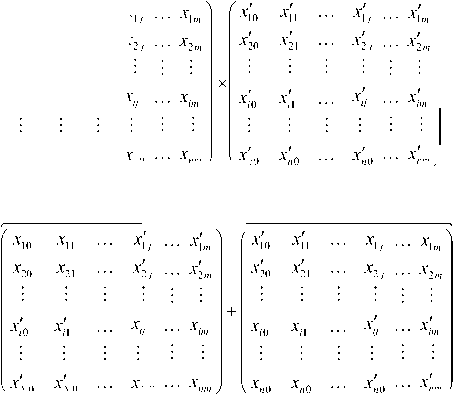
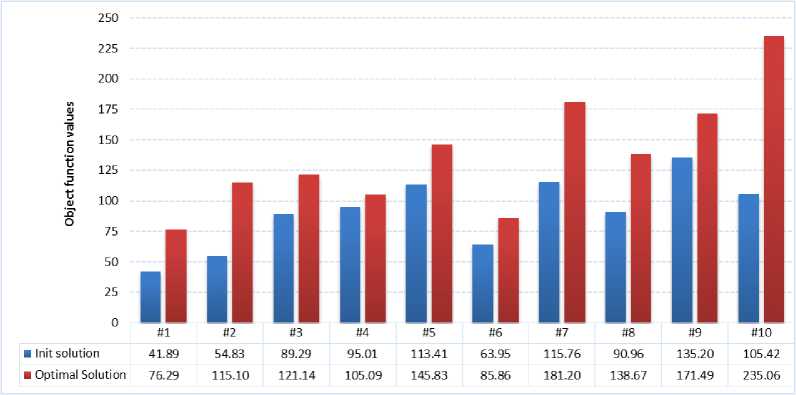
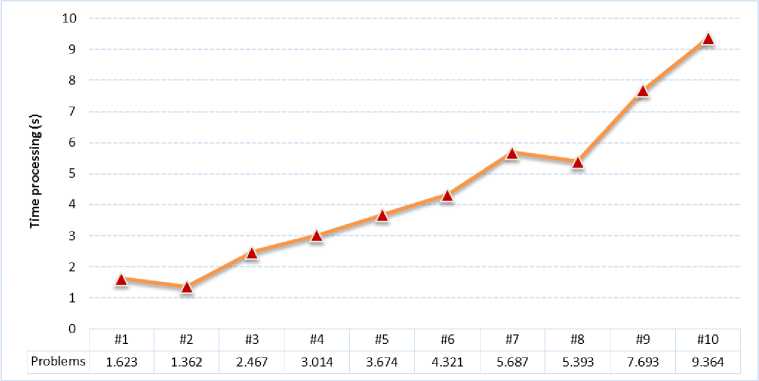
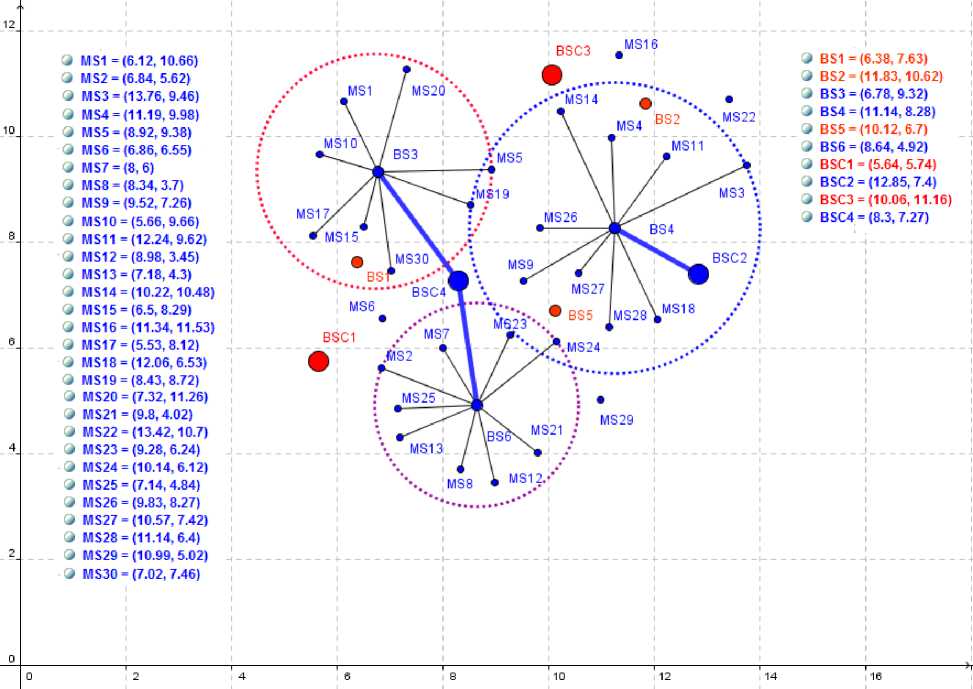
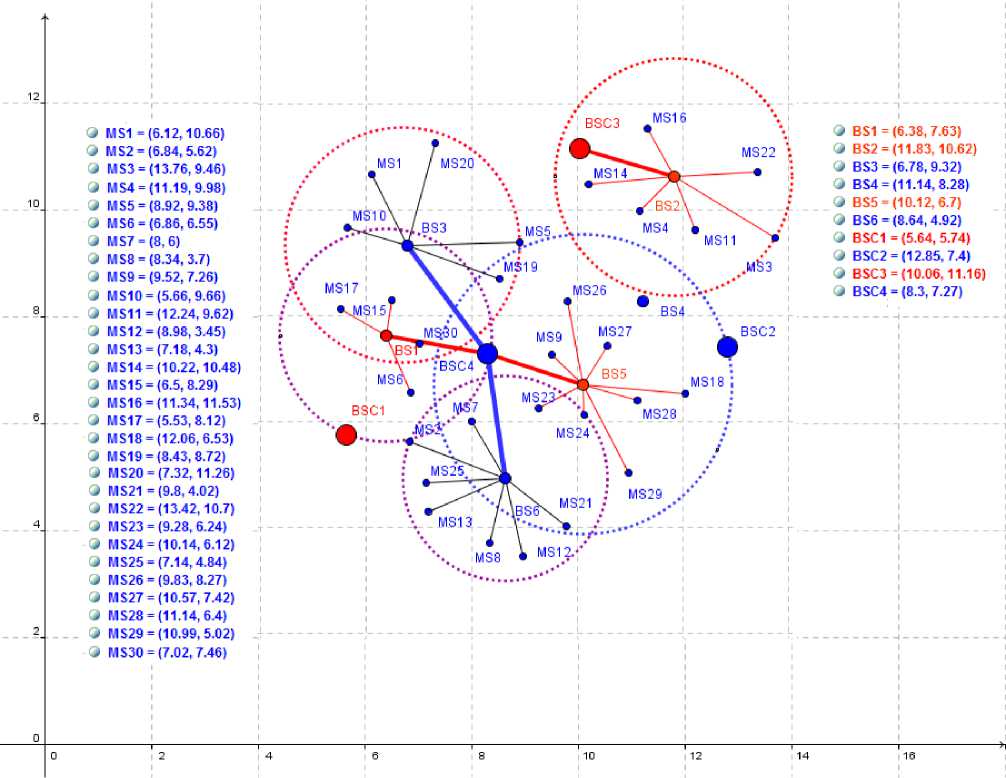
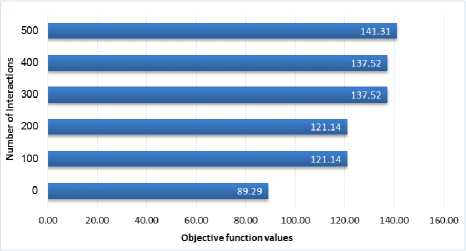
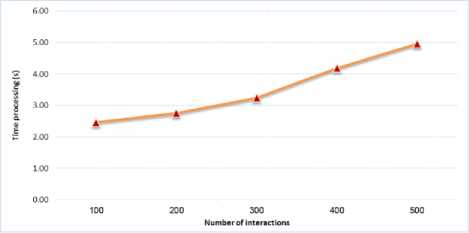
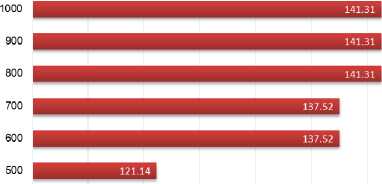
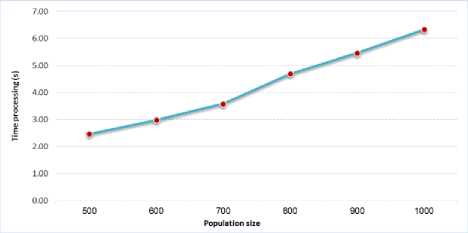
Список литературы Improving Genetic Algorithm to Solve Multi-objectives Optimal of Upgrading Infrastructure in NGWN
- Commworks, Wireless Data for Everyone. http://www.commworks.com. Technical Paper, 3Com Corporation, 2001.
- Siemens Mobile. UMTS. http://www.siemens.de. White Paper, 2001.
- Mirzaian, A. and K. Steiglitz. A Note on the Complexity of the Star-Star Concentrator Problem. IEEE Transactions On Communications. No. 29, pp.1549-1552, 1981.
- Gavish, B. A System for Routing and Capacity Assignment in Computer Communication Networks. IEEE Transactions of Communications, No. 37, pp. 360-366, 1989.
- Narasimhan, S. and H. Pirkul. The Hierarchical Concentrator Location Problem. Computer Communications, Vol. 15, no. 3, pp. 185-191, 1992.
- Gupta, R. and J. Kalvenes. Hierarchical Cellular Network Design with Channel Allocation. In Proceedings of the Ninth Annual Workshop on Information Technologies & Systems. pp. 155-160, 1999.
- Kalvenes, J., J. Kennington and E. Olinick. Base Station Location and Service Assignment in W-CDMA Networks. Technical Report 02-EMS-03. SMU, 2002.
- Mathar R. and T. Niessen. Optimum positioning of base stations for cellular radio networks. Wireless Networks. Vol.6, No.6. pp. 421-428, 2000.
- Mathar R. and M. Schmeink. Capacity Planning of UMTS Networks. In Proceedings of Sixth INFORMS Telecommunications Conference, Boca Raton, Florida 2002.
- Lee, C.Y. and H. Kang. Cell Planning with Capacity Expansion in Mobile Communications: A Tabu Search Approach. IEEE Transactions on Vehicular Technology. Vol. 49, No. 5. pp. 1678-1691, 2000.
- Calegari, P., Guidee, F., Kuonen, P. and Wagner, D. Genetic approach to radio network optimization for mobile systems. IEEE VTC, pp. 755-759, 1997.
- Yu, C., S. Subramanian, and N. Jain. CDMA cell site optimization using a set covering algorithm. In Proceedings of Eight Int. Network Planning Symposium, pp. 75-78, 1998.
- Giuliano, R., F. Mazzenga, and F. Vatalaro. Smart cell sectorization for third generation CDMA systems. Wireless Communications and Mobile Computing. Vol. 2, Issue 3, pp. 253-267, 2002.
- Dac-Nhuong Le, Genetic Algorithm Applied to the Optimal Centralized Wireless Access Network, International Journal of Information & Network Security (IJINS), Vol.2(2), pp.129-137, 2013.
- Dac-Nhuong Le, and Nhu Gia Nguyen, A New Evolutionary Approach for Gateway Placement in Wireless Mesh Networks, International Journal of Computer Networks and Wireless Communications (IJCNWC), Vol.2(5), pp.550-555, 2012.
- Dac-Nhuong Le, PSO and ACO Algorithms Applied to optimal Resource Allocation to Support QoS Requirements in Next Generation Networks, International Journal of Information & Network Security (IJINS), Vol.2(3), pp.216-228, 2013.
- Dac-Nhuong Le, PSO and ACO Algorithms Applied to Optimizing Location of Controllers in Wireless Networks, International Journal of Computer Science and Telecommunications (IJCST), Vol.3(10), pp.1-7, 2012.
- Dac-Nhuong Le, Nhu Gia Nguyen, and Vinh Trong Le, A Novel Ant Colony Optimization-based Algorithm for the Optimal Centralized Wireless Access Network, in Proceeding of Lecture Notes of the Institute for Computer Sciences, Social Informatics and Telecommunications Engineering (LNICST), Springer 2013.
- Dac-Nhuong Le, Optimizing the cMTS to Improve Quality of Service in Next Generation Networks based on ACO Algorithm, International Journal of Computer Network and Information Security (IJCNIS), Vol.5, No.4, pp.25-30, 2013.
- Dac-Nhuong Le, EA and ACO Algorithms Applied to Optimizing Location of Controllers in Wireless Networks, International Journal of Network Communication and Networking (IJNCN), Vol.3, No.2, pp.17-27, 2013.
- An, Telecommunication planning of Haiphong city to 2020. Department of Information and Communication, 2009.
- Department of Information and Communication. Strategies to development Post and Telecommunications in City Haiphong from 2009 to 2020. July 2009.

